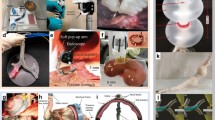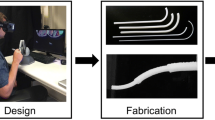Abstract
Dexterity of robots is highly required when it comes to integration for medical applications. Major efforts have been conducted to increase the dexterity at the distal parts of medical robots. This paper reports on developments toward integrating biocompatible conducting polymers (CP) into inherently dexterous concentric tube robot paradigm. In the form of tri-layer thin structures, CP micro-actuators produce high strains while requiring less than 1 V for actuation. Fabrication, characterization, and first integrations of such micro-actuators are presented. The integration is validated in a preliminary telescopic soft robot prototype with qualitative and quantitative performance assessment of accurate position control for trajectory tracking scenarios. Further, CP micro-actuators are integrated to a laser steering system in a closed-loop control scheme with displacements up to 5 mm. Our first developments aim toward intracorporeal medical robotics, with miniaturized actuators to be embedded into continuum robots.










Similar content being viewed by others
References
Amanov, E., J. Granna, J. Burgner-Kahrs. Toward improving path following motion: hybrid continuum robot design. In: IEEE International Conference on Robotics and Automation, 2017, pp. 4666–4672.
Anor, T., J. Madsen, P. Dupont. Algorithms for design of continuum robots using the concentric tubes approach: a neurosurgical example. In: IEEE International Conference on Robotics and Automation, 2011, pp. 667–673.
Burgner-Kahrs, J., D. C. Rucker, and H. Choset. Continuum robots for medical applications: a survey. IEEE Trans. Robot. 31(6):1261–1280, 2015.
Carpi, F., E. Smela. Biomedical Applications of Electroactive Polymer Actuators, Wiley Online Library, 2009.
Chikhaoui, M. T., A. Cot, K. Rabenorosoa, P. Rougeot, N. Andreff. Design and closed-loop control of a tri-layer polypyrrole based telescopic soft robot. In: IEEE/RSJ International Conference on Intelligent Robots and Systems, 2016, pp. 1145–1150.
Chikhaoui, M. T., A. Cot, K. Rabenorosoa, P. Rougeot, N. Andreff. Towards biocompatible conducting polymer actuated tubes for intracorporeal laser steering. In: Hamlyn Symposium on Medical Robotics, 2017, pp. 79–80.
Chikhaoui, M. T., K. Rabenorosoa, and N. Andreff. Kinematics and performance analysis of a novel concentric tube robotic structure with embedded soft micro-actuation. Mech. Mach. Theory 104:234–254, 2016.
Cianchetti, M., T. Ranzani, G. Gerboni, I. De Falco, C. Laschi, A. Menciassi. STIFF-FLOP surgical manipulator: mechanical design and experimental characterization of the single module. In: IEEE/RSJ International Conference on Intelligent Robots and Systems, 2013, pp. 3576–3581.
Cot, A., M. T. Chikhaoui, P. Rougeot, K. Rabenorosoa, N. Andreff. Synthesis, encapsulation, and performance analysis of large deformation tri-layer polypyrrole actuator. In: IEEE International Conference on Advanced Intelligent Mechatronics, 2016, pp. 436–441.
Couture, T., and J. Szewczyk. Design and experimental validation of an active catheter for endovascular navigation. J. Med. Devices 12(1):011003, 2017.
Gairhe, B., G. Alici, G. M. Spinks, and J. M. Cairney. Synthesis and performance evaluation of thin film PPy-PVDF multilayer electroactive polymer actuators. Sens. Actuators A 165(2):321–328, 2011.
Gilbert, H. B., D. C. Rucker, and R. J. Webster III. Concentric tube robots: the state of the art and future directions. In: Robotics Research. Springer Tracts in Advanced Robotics, edited by M. Inaba, and P. Corke. New York: Springer, 2016.
Ha, J., F. Park, and P. Dupont. Elastic stability of concentric tube robots subject to external loads. IEEE Trans. Biomed. Eng. 63(6):1116–1128, 2015.
Ikeuchi, M., K. Ikuta. Development of pressure-driven micro active catheter using membrane micro emboss following excimer laser ablation (MeME-X) process. In: IEEE International Conference on Robotics and Automation, 2009, pp. 4469–4472.
Kudryavtsev, A. V., M. T. Chikhaoui, A. Liadov, P. Rougeot, F. Spindler, K. Rabenorosoa, J. Burgner-Kahrs, B. Tamadazte, and N. Andreff. Eye-in-hand visual servoing of concentric tube robots. IEEE Robot. Autom. Lett. 3(3):2315–2321, 2018.
Li, Z., L. Wu, H. Ren, and H. Yu. Kinematic comparison of surgical tendon-driven manipulators and concentric tube manipulator. Mech. Mach. Theory 107:148–165, 2017.
Nam, J., Y. Kim, and G. Jang. Resonant piezoelectric vibrator with high displacement at haptic frequency for smart devices. IEEE/ASME Trans. Mechatron. 21(1):394–401, 2016.
Rosa, B., M. S. Erden, T. Vercauteren, B. Herman, J. Szewczyk, and G. Morel. Building large mosaics of confocal edomicroscopic images using visual servoing. IEEE Trans. Bio-Med. Eng. 60(4):1041–1049, 2013.
Shoa, T., J. D. W. Madden, N. R. Munce, and V. Yang. Analytical modeling of a conducting polymer-driven catheter. Polym. Int. 59:343–351, 2010.
Sun, J., and H. Xie. MEMS-based endoscopic optical coherence tomography. Int. J.Opt. 2011. https://doi.org/10.1155/2011/825629.
Webster, III, R. J., and B. A. Jones. Design and kinematic modeling of constant curvature continuum robots: a review. Int. J. Robot. Res. 29(13):1661–1683, 2010.
Wu, L., R. Crawford, and J. Roberts. Dexterity analysis of three 6-DOF continuum robots combining concentric tube mechanisms and cable-driven mechanisms. IEEE Robot. Autom. Lett. 2(2):514–521, 2017.
Xu, K., R. E. Goldman, J. Ding, P. K. Allen, D. L. Fowler, N. Simaan. System design of an insertable robotic effector platform for single port access (SPA) surgery. In: IEEE/RSJ International Conference on Intelligent Robots and Systems, 2009, pp. 5546–5552.
Yamaura, M., T. Hagiwara, and K. Iwata. Enhancement of electrical conductivity of polypyrrole film by stretching: counter-ion effect. Synth. Metals 26(3):209–224, 1988.
Yip, M. C., and D. B. Camarillo. Model-less hybrid position/force control: a minimalist approach for continuum manipulators in unknown, constrained environments. IEEE Robot. Autom. Lett. 1(2):844–851, 2016.
Acknowledgments
This work has been supported by the Labex ACTION project (contract “ANR-11-LABX-0001-01”), the Equipex ROBOTEX project (contract “ANR-10-EQPX-44-01”), and the French RENATECH network and its FEMTO-ST technological facility.
Author information
Authors and Affiliations
Corresponding author
Additional information
Associate Editor Joel Stitzel oversaw the review of this article.
Rights and permissions
About this article
Cite this article
Chikhaoui, M.T., Benouhiba, A., Rougeot, P. et al. Developments and Control of Biocompatible Conducting Polymer for Intracorporeal Continuum Robots. Ann Biomed Eng 46, 1511–1521 (2018). https://doi.org/10.1007/s10439-018-2038-2
Received:
Accepted:
Published:
Issue Date:
DOI: https://doi.org/10.1007/s10439-018-2038-2




